- How to Condition for Your First LD with the Bare Minimum of Effort
- My QH is a Badass
- Praise the Weather Gods
- Luckier Than a 3-Legged Dog Playing Frogger on a 6-Lane Interstate
ARABIAN AND NON-ARABIAN BREEDS IN ENDURANCE
I want to state up front that I am in no way advocating for one breed over any other in the sport of endurance riding. I do not intend any kind of negative words/thoughts/energy toward any breed through this post. These are simply my thoughts and opinions based on my personal experience with a non-Arab in the world of AERC limited distance endurance riding (where n=1, which is not a significant statistic, folks, and I totally get that).Competing a non-Arab breed in endurance (LDs or otherwise) isn't a remarkable feat. People do it all of the the time with great success. Many people prefer a non-Arab over an Arab for endurance for various reasons. It's awesome that so many breeds have found success at the sport.
But I will say, from my observations over the years, Arabians and Arabian crossbreeds (henceforth referred to as "Arabs" as a group) do have a significant advantage the majority of the time. (There are freakazoid individuals in any breed that can rival them, but these individuals are often few and far between.)
Arabs have metabolics that lend themselves very easily to the sport of endurance. They often pulse down to criteria (commonly 64 bpm or 60 bpm) quicker and more easily that non-Arabs. Additionally, Arabs often hold their conditioning fitness more easily (and often longer) than non-Arabs. As I commonly told my non-horse friends who didn't understand why conditioning Stan was different from conditioning Q, "Q is genetically superior. She's like the elite athletes from a family of other elite athletes you see that consistently kill it in a marathon year after year. Stan is your average run-of-the-mill blue collar worker who likes to watch TV more than exercise. One is infinitely easier to condition than the other." I'm sure you could come up with various analogies to get to the same point.
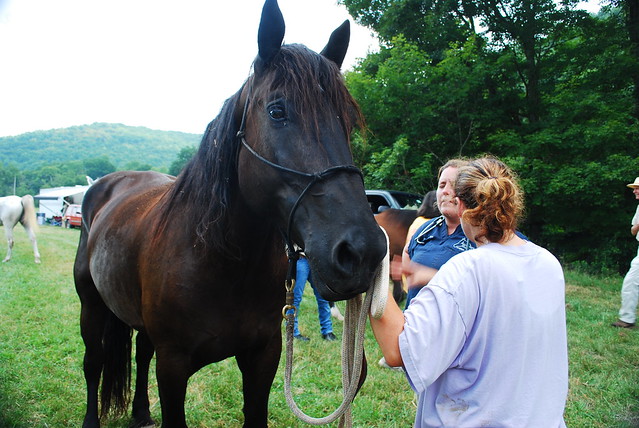 |
| Not an Arab. This mare is a Percheron/QH who was a pretty common sight at east coast LDs. Her owner now has a Belgian. |
None of this means that non-Arabs are sub-par or lesser within this sport! Oh, no. It just means that their human partners often work a little more "outside of the box" so far as managing them for success. And that's awesome. Those people are often better horsemen due to it. There is a lot to be said for knowing multiple ways to manage certain conditions instead of just sticking to one method.
CONDITIONING STAN: PAST and PRESENT TIME & MILES
When I conditioned Stan for RBTR it's first year in 2007, I didn't know what the HELL I was getting into. Sonya (his owner then) knew that the club was putting on the ride in August and that it was basically a long trail ride. She looked on the internet and found an endurance conditioning article beginners, printed it off, and gave it to me one evening at the barn. I don't remember what that article said other than recommending riding for at least an hour a day, 5 days a week. I'm pretty sure they assumed people would be conditioning in an arena for the majority of these hours.Well, I didn't have an arena; I had trails at my disposal. I had many trails over mountains, and on what we originally hoped would be the RBTR course. It wasn't easy terrain by any breadth of the imagination. So, I applied that article in my own way and I rode Stan a minimum of 5 days a week for an hour to three hours each time on the trails at a trot and canter. He was in killer shape. I can't tell you how his pulsing was, but I know it had to have been better than it was this year!
In contrast to 2007, my conditioning for RBTR 2017 looked like this:
- January - 8 total rides of which 2 were trail rides recording 14.3 trail miles.
- February - 4 total rides of which 3 were trail rides recording 10.4 trail miles.
- March - 2 total rides of which both were trail rides recording 7.1 trail miles.
- April - 4 total rides of which 3 were trail rides recording 9.1 trail miles.
- May - 7 total rides of which 5 were trail rides recording 30.6 trail miles
- June - 5 total rides of which all were trail rides recording 47 trail miles.
- July - 7 total rides of which 6 were trail rides recording 60.45 trail miles.
In total, from January through July, Stan completed 178.95 miles over the course of 26 trail rides.
That's like...nothing. Especially considering what we'd done in the past and what I've done with Q in 2012-2014 when I was originally legging her up for the various endurance distances LD through 50. When legging Q and Griffin up in more recent years, we'd rack up ~180 miles in 3½ months not 7!
Regardless, while I knew Stan and I didn't have the quantity of miles I wanted to have under our belts from conditioning, I didn't question his ability to complete 30 miles. Hell, we'd had one ride of 23 miles in each June and July that he handled beautifully over terrain similar to - possibly harder than - RBTR terrain. But completing miles is only half the battle with endurance. The other half is pulsing to criteria intermittently throughout the completion of those miles (keeping metabolics at good levels). And pulsing to criteria during hot, humid summer days isn't easy.
CONDITIONING STAN: HR RECOVERIES
See, I'd also been monitoring Stan's recoveries during several of our July workouts. And frankly, his recoveries sucked. After one particular hill sprint workout on a sunny 81ºF day (above normal for us this summer; it's been in the mid-70s a lot) with relative-high humidity and little to no breeze, he was around 100 bpm 15 minutes after work, at 76 bpm after an additional 30 minutes in which I actively cooled him with a cold hose and scraping, and at 66 bpm after yet another additional 34 minutes where he stood quietly and calmly with a buddy in the shady barn. That's downright horrible. And that was on July 27, 9 days before the race. Yeah...So the fact that I was a bit erm, spazzy? about our chances of completing RBTR this year from a meeting-pulse-criteria standpoint wasn't too ludicrous. We didn't have the level of conditioning we should have had. At. All.
Now, let's take into consideration that he'd just done 11 hill sprints at full-bore effort and he'd never be expected to do that during a ride. His HR should have no reason to be nearly that high at any point in the race. Period. But STILL. That his recovery was that piss poor 1 hour and 19 minutes after max exertion was of great concern to me. (Thankfully there was nothing going on behind the scenes to contribute to his poor HR recovery. He's just a QH dealing with stupid humid weather with no movement of air. His human (hai!) with her pale skin and red hair who acclimates better to cold than heat was also pissy and hot and having trouble keeping her own HR low due to the weather, too.)
So, following that ride I sent texts to my endurance mentor and another endurance rider who has successfully competed a non-Arab over many miles with mostly top 10 completions asking for help. Through conversations with them, the next time I rode Stan on July 29 (13 flat miles on the rail trail at only a trot), I electrolyted him immediately before and after the ride and gave him 40cc of calcium gluconate afterwards, too. I also made a point to walk him the final ¾-mile to the barn so he could have a chance to get his HR down.
When I hopped off at the barn, I administered the electrolytes and calcium gluconate and checked his HR. 54 bpm! Boom.
The weather for this 13-mile ride was a cool 64ºF with a slight breeze and overcast skies. I'd be a complete dumbass if I didn't note how
RACE DAY SUCCESSES
The 13-mile ride left me feeling a lot more optimistic about RBTR than I had days prior. Still, I knew the weather was going to play a HUGE FREAKING ROLE in how hard or easy success would come to us re: meeting pulse criteria. Fortunately, as of July 29, a cold front was predicted to hit the night before the ride; the weather on ride day would be overcast with a high of 64ºF.This kind of weather report can and will change, but I was grateful and very fortunate it held through this year. The prediction for weather on race day Friday morning before the ride was partly cloudy with a high of 71ºF. The actual weather ended up being in the upper 50s and low 60s with overcast skies until around noon when the clouds broke up and the sun broke through to bring things to the predicted high of 71ºF. There was a steady 5-10 mph breeze from morning to night.
Knowing what I know, doing my homework, and planning to control all I could from the italicized factors above, I found success on race day due to:
- THE WEATHER. Race day was 60-68ºF with low humidity and 5-10 mph breezes. Cloud cover dominated for 75% of our ride with patchy sunshine for the final quarter.
- KNOWLEDGE OF TRAIL. I know the RBTR trails very, very well and knew where I could afford to move out and where I should save a little.
- CONDITIONED TO CLIMB. While deficient in time and miles, our training included copious gains in elevation. While Stan lived in Canaan, (yeah, still no good situation in Canaan so all horses are once again a 50 minute drive from me) our rides included a minimum of 1,000' elevation gain each. Stan and I only did 9 conditioning trail rides between June 3 and July 21. A conservative estimate is that Stan climbed 9,000 feet. When you go through my GPS statistics and actually calculate the total elevation gain from all 9 rides you discover that we climbed at least 11,880 feet over 90.15 miles. That certainly doesn't suck! I'm very fortunate to have access to terrain like this for conditioning.
- HISTORY. My history with Stan facilitated our training and movement down the trail in both conditioning and competition. Our relationship spans 10+ years with a solid few years of nothing in the middle. Fortunately, Stan is such that he picks up right where he left off after any length of time. He was fatter and less in shape for his 5 years as a pasture puff when he entered my life again on July 31, 2016, but his mind was just as wonderful as it's always been.
- ELECTROLYTES. I dosed Stan 2x on Friday with a 50/50 mix Perform 'N Win & Enduramax mixed with apple juice and molasses. I dosed him again before the ride on Saturday morning and at the hold with the same. At the finish when he had issues with cramping in his hind end, I dosed him with the calcium gluconate. He drank beautifully all day long, increasingly so as the day wore on. Shy of the weather, I firmly believe the horse had another loop in him and could have completed 50 miles.
Really, the way I look at it, what it all boils down to is the weather. I got luckier than shit with the weather forecast. If the weather had been its typical humid, muggy, hot, no-breeze, temperatures in the 80s, we would have had a MUCH different day. That day would have been infinitely slower in average pace (5 mph vs. the 7 mph we achieved) and I would have spent a lot longer on my own two feet than in the saddle heading back into the hold and finish (1 mile instead of ½-¾-mile).
CONCLUSION
So, what's the point of this post? Well, mostly I wanted to document all of this for my future self while it's fresh in my mind. But also, I want to put out there to the world that you CAN condition a non-Arab for this sport and find success without riding 15+ miles per week for 5+ months. I've told people for years that any [sound, healthy] horse can go out and complete an LD within the time criteria. And now I've lent more support to that statement from my own experiences this summer.I've also said that with continued management of fitness following a successful LD, any [sound, healthy] horse can go out and complete a 50(+) mile endurance ride, provided you have some checks and balances in place for managing your metabolics. Metabolics make things trickier though and require more initiative on the part of the rider, so this statement is one I've only stated cautiously to specific audiences.
Certainly, a variety of factors, especially the weather and terrain that you condition and compete over, play into the game of success for this sport. But the conditioning side of things really isn't as daunting as it seems. In a 7 month training period, I never rode Stan more than 60 miles in a month. I never worked Stan more than 8 times in a month in any fashion. You can break these numbers down by the days in a month in various ways to visualize how little effort this is over the course of time one has available. It's SO possible.
So, what do you think? Have you ever wondered about giving this sport a try whether for cross-conditioning for another discipline or just to see if you could go the distance? Maybe you've never considered it, but you've got a pretty fit horse that's been participating in HTs, dressage, or hunter paces and now the wheels are turning in your head about the possibility of pursuing an LD? Whether to simply cross it off the list of "Things Tried" or to cross-condition for another sport or even to give you a little more drive and impetus to get out and ride your horse with a goal-driven purpose, I encourage you to give it a go if you're interested. It's pretty fun to spend the time and miles with horses and friends traveling across beautiful countryside.


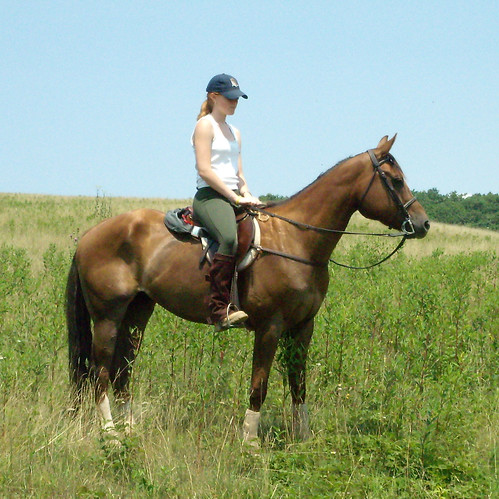
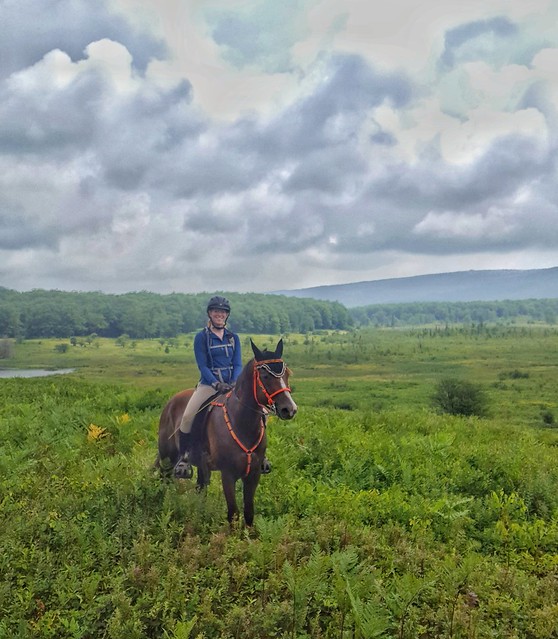
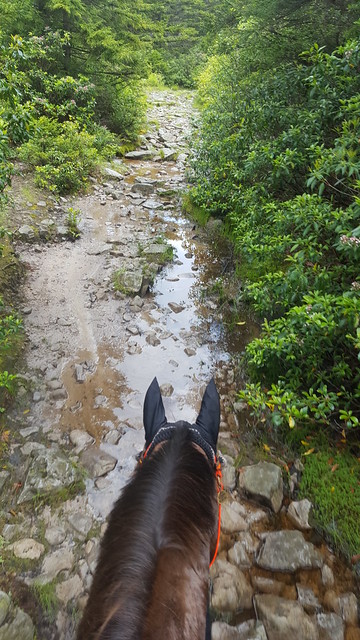

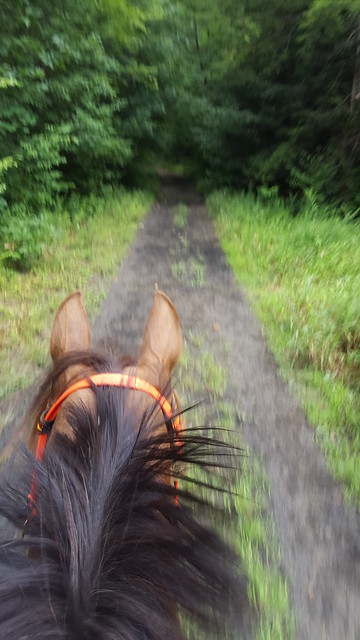
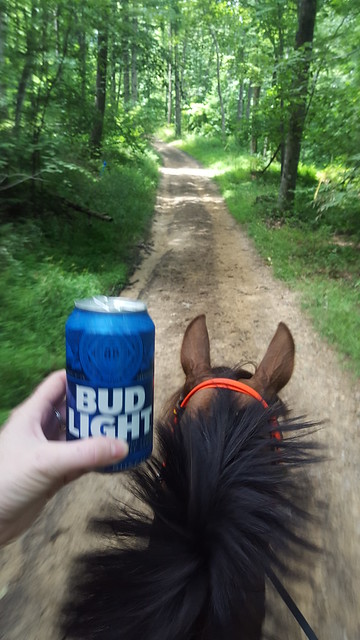
THIS IS GREAT!! I am feeling excited and even more like completing an LD with Dino in the spring is POSSIBLE! Do you have a GPS app that you recommend? And is there such a thing as a sugar-free electrolyte that would be safe for my Cushing's pony? And is a "hill sprint" just galloping up hills? I HAVE QUESTIONS! :D
ReplyDeleteTotally possible! I used the Endomondo app (purchased for $3-$5) for years and years successfully. I now ride mostly with a Garmin 310XT watch, but on the days I forget it I still use my phone. I don't sync my Garmin watch often, but when I do sync it all of the data syncs to my Endomondo account still. I love it.
DeleteI'm certain there are sugar-free electrolyte options out there. A lot of people even make their own concoctions. I don't think the sugar in the actual electrolyte mixes is great, but is moreso contained in the medium you deliver the electrolytes to the horse. I use apple juice or applesauce and molasses only because my horses think they're getting a treat instead of tortured lol. Explore the AERC: American Endurance Ride Conference facebook group and search it for "sugar-free electrolyte" and I bet you'll find some old threads. If not, throw the question out there and I know some of the geeky metabolics people are bound to answer.
And yes, "hill sprint" merely means sprinting full bore up a hill. When I do them we sprint to the top, pause for a few breaths, then walk down and repeat. Sometimes I'll trot a big circle at the base of the hill if it's a flat area before powering up again. Set a realistic goal in the beginning based on the size of your hill for how many reps you'll do. It's just like HIIT training for your own body, but for your horse. I'm often very flexible with how many we do based on the day, weather, and how my horse is feeling. I'll often set out to do X many but end up doing Y many instead.
Thank you thank you!! Looking forward to getting both of us in shape for Foxcatcher! And I just made the connection this morning that I know Holly from my job - she has been a client of ours on-and-off for years! :D
DeleteThis is fascinating. Well done.
ReplyDeleteThank you. I thought about Zoebird when I posted the photo of Annie, the draft cross.
DeleteLove this post! Dabbling in endurance has made me really want to do more of it! I am so surprised there's not more people in my area, since the trails here are so hilly and extensive that they would make training a lot of fun!
ReplyDeleteYOu DO have great trails that would so perfect for training. I love what I've seen and ridden over there so far. There are a lot of people in your general region. Three decades-long competitors for sure and probably others I don't know about. A lot of them trailer away one or two weekends a month to get on some trails with more rocks and elevation gain.
DeleteAusten, I'm not sure of your EXACT location, but there are lots of people in what I think is your area :)
DeleteI have often said that any horse in regular work can do an LD, provided that he has no medical issues. Most can be conditioned to do 50's as well. With that said, as someone who started in endurance on non-Arabs and has ridden about 50/50 Arabs/non-Arabs, the Arabians do have certain advantages. It is interesting to read your thoughts regarding Stan specifically. In some ways, he is not your typical QH, which probably helps you out in some ways. I would love to see you do the longer distances with him and continue talking about how you condition him for it. As you know, Ozzy did 50's and is a 16hh TANK of a horse. The journey to get him through was definitely a learning experience for me and made it so much easier when I started riding "real" endurance horses down the line :)
DeleteOzzy is such a tank! And your stories about him are still some of my favorites. =)
DeleteArabs absolutely have advantages! And personally, I enjoy the sport more with them just because there are less factors in the equation overall (electrolyting, pulsing, blah blah blah). I definitely appreciate the fewer factors involved with competing Q after my experience with Stan.
I would love to try this with Savvy. The trails in my area are not particularly challenging though. The landscape you have at your disposal looks amazing!
ReplyDeleteNo need for challenging trails! If rides in your region have similar terrain to what you have to condition on, that's all you need. I hit the mountains hard only because I have them at my disposal...hell, where I kept Stan FORCED me to climb more than I ever have before. I know plenty of endurance riders that live in flatter areas and still compete successfully over mountainous rides. They're a little more creative and forgiving about where they move out on trail (trotting downhill on gravel roads for instance) to make up for walking technical stuff, but they absolutely find success and make it work.
DeleteI remember doing okay in hilly distance races/runs (as a human) even though I only had access to the world's flattest countryside to train on. You can get really creative with things, like running into the wind or weight lifting. I'm sure the same goes for horses. Hell, my horse has zero problems with hills probably due to all the work he does in collection. He just motors up.
DeleteYES, Austen! Spot. On. I've met several people in endurance (usually men) who like to do all of the conditioning with their horses using a heavy saddle and then on race day they like to throw someone our size on board with a much lighter saddle. The horses fly! I should maybe utilize the 50# saddle at our barn more in the future.... lol
DeleteI do the heavier saddle bit + load it up with every saddle bag and water bottle I can find. I also put a man in the saddle on the horse that I need more conditioned.
DeleteI noticed similar things with Gwyn, and she's mostly draft (friesian perch appy) She can complete with fine metabolics, especially if the weather is cool and the two LDs I've done with her have been in cooler weather. The intro rides I've done have been in hotter weather and she was still fine. I think for her to be okay at 50 miles we'd definitely need more conditioning rides than I can manage now and on more difficult terrain than I easily have access to, but with a little effort it wouldn't be impossible.
ReplyDeleteThat's such a cool sounding cross! That's awesome that you've gotten out and found success with her already. It sounds like you have a good conditioning program already. 50-mile horses are made through very similar conditioning for an LD, but just over a little longer time period - you'll get there!
DeleteI hear you on the cooler weather bit! I think if I ever pursue more with Stan I'll make a point of focusing on the cooler times of year to plan my rides. It just takes some of the stress out of the equation, which I like.
Best photo of the post: Bud Light in hand. LOL LOL! Love it!!!
ReplyDelete<3 Kelly @ HunkyHanoverian
Hahaha yep! Stan made drinking a beer on the go way more fun since he isn't very spooky. I just dropped my reins and rode along while he did his job. Such a blast.
DeleteSo you're telling me there's a beer drink'n sport for me and the beer drinking horse I bought? SOLD.
ReplyDeleteNo, in all seriousness, this post is great. Many places within "popular" endurance culture only feature the Arab or Arab-Cross breeds. I was excited when I learned several Tennessee Walkers completed Tevis this year for no other reason than, well, I didn't know other breeds could.
Stan killed it, but several other breeds completed at the ride this year, too. Honestly, after seeing the Draft finish, as tired as she may be, the LD seemed much more doable. This answered several questions I've been meaning to ask you. Thanks for posting!
Oh yeah TWH are out there in the sport! A blogging friend Funder competed her spotted TWH mare through a 100. It's all documented on her site at fundersgoodidea.com As well, I read threads on the endurance groups pretty often about people competing TWH. Gotta watch your electrolytes more it seems, but no reason not to get out there and do the thing!
Deletei love this! esp with how thoughtful and systematic it is. i've never done any true 'distance' type ride - the longest have been like.... 8 mile hunter paces lol. maybe one day tho!
ReplyDeleteHunter paces sound like they keep a similar - if not faster! - pace than an endurance ride, too. So while the distance was limiting, you've got a feel for how you'd keep pace on an endurance ride which is a leg up if you ever decided to give one a go. I hope to one day find a chance to try a hunter pace - they sound like so much fun!
DeleteI love this! Georgie is a QH/TB but acts much more QH. I took extra precautions to get her fit for the Training 3Day and I LOVED having a fit and capable horse. Sure, people with Arabs and TBs may have it a bit easier, but the bonding and fun I had with Georgie on those conditioning rides can't be replaced.
ReplyDeleteThe bond built during conditioning is such a special one. I enjoyed spending the time with Stan, even if he wasn't exactly convinced at the time lol
DeleteLike many others riding a Non-Arab, conditioning was the most intimidating part of breaking into this sport. At my very first (intro) ride I had a lady scare me when she told me she rode 25-30 miles a week before she ever attempted an LD. But then my POA completed a slow (flatland) LD after only about 3 weeks of actual conditioning and later ended up 27th (out of like 75 starters) at Foxcatcher a little over a month later, shaving more than an hour off her previous time. I never rode her more than 2x a week or more than 10 miles at a time and our average pace was 4.5 mph during our training rides. I'm not saying this is advisable (I personally think she is a freak of nature) but it helped me realize you don't have to ride the crap out of your horse to be successful, even if you ARE on a non-arab. :) Congrats to you and Stan! I'm so excited to see someone competing a Quarter Horse in this sport!
ReplyDeleteThat's AWESOME! And yes, there are so many freak of nature horses in endurance re: fitness/metabolics. And YES to not riding the crap out of them. Once I found success at 50s with Q and my mind eased a bit, I realized how important REST is for them. All those micro tears build up if you ride the piss out of them. I think they benefit from time off as much as conditioning.
DeleteThe more time goes on, the more I love POAs. I have 2 friends with them and have met a third through endurance. My first 100 at OD I rode with one for a third of the ride and leap frogged with a second near the end. The one I met near the end completed OD as her 5th 100 in a pretty short time frame. So amazing. What an incredible breed of horse.
One thing I want to add: 24/7 pasture turnout on real acreage makes a HUGE DIFFERENCE in the horse's baseline conditioning regardless of breed, and this MUST be noted. A horse that lives in a stall or a stall + small paddock or that gets turned out for only 12 hrs a day on a flat manicured field, or that lives alone in an acre lot is going to need a lot more work than Stan, who has spent most of his life on 24/7 turnout on large acreage, most of it hilly. There are studies to back this up and it is mentioned repeatedly by the endurance masters, including Aarene Storms in her Endurance 101 book. This needs to be noted when addressing new riders to the sport, especially those on non-Arabs. Sorry, this time it is unsolicited advice, but that was one of the first things I changed when I decided to aim for endurance with my non-Arab: I moved her to 24/7 turnout in a herd environment.
ReplyDeleteOh yeah. Turnout plays a HUGE role for sure. Stan was on 20+ acres for most of his life, though this summer he was only on 2½ acres for June and July! It's definitely a benefit to training to have a great turnout situation though. Good point!
DeleteCongrats again on your completion. When we were conditioning Pete (draft cross) for an LD he did all the same miles as Gem and lived the same lifestyle and barely pulses down to criteria even on a rainy late October day in the Midwest. It really is a whole different sport when on an non Arab and your great completion just speaks to how much care you put into both the conditioning and the ride day. I honestly believe one of the biggest issues in the sport is over conditioning.
ReplyDeleteDang, Pete! That's nuts about his pulse not dropping with that kind of weather at that time of year after his conditioning schedule. I've witnessed the same from a lot of non-Arabs over the years though. It's just crazy how much genetics can play into the whole equation for different breeds in this sport. Your Gem is still one of the most impressive I've ever seen with how she displays her fitness at a ride.
DeleteI think a lot of non-Arabs would be more successful at the sport if they weren't electrolyted as Arabians. Arabs have distance in their blood to the point where their requirements are nowhere near what a non-Arab's are. I never would have been able to complete another distance ride on Lily if it hadn't been for Dr. Arthur King's recommendation to elyte as aggressively as I do. Aarene Storms competes a large, dark Standardbred successfully in the cool Pacific Northwest on an elyte protocol that is exactly what I use. (She wrote a detailed post about Fiddle's electrolyting a while back.) Non-Arabs have a higher potassium requirement than Arabs too, which is something that has been told to me over and over and over by more experienced riders that also ride non-Arabs in the sport in this region. I initially trailed Gracie wth a different, less aggressive protocol and she had both an arrhythmia and a hanging pulse at her first LD because of it. How did I fix it? Potassium. And she completed. My one metabolic pull with Gracie last year? I didn't elyte her enough due to the saddle bag snafu at Fort Valley. Once I got enough potassium in her, her heart rate dropped. Same thing with Lily at Fort Valley in 2014. She wouldn't have needed the potassium IV if I'd been giving it orally throughout the day. Another thing to note: the elyte protocol for a non-Arab doesn't change when it's cooler. I elyte the same, and so do most of the people I have talked to on the subject. We sometimes supplement with more sodium if we're concerned about not drinking due to cooler weather, but I find it dicey because even in cooler weather, even the best-conditioned non-Arabs can still run hotter than an Arab. I still want mine getting their potassium in addition to my elyte of choice (Perform n' Win only. I was told to avoid Enduramax in non-Arabs because it's more likely to give them hanging pulses and cramps. Can't testify as to that, but I just stick with what has worked so far. *shrug*)
DeleteLet me say that Stan in that photo above looks AMAZING! I would love to do a short ride not a long one with Carmen. But really I probably just want to go on a long trail ride. :)
ReplyDeleteThank you! Trail riding has always spoken to me so much - I think it stems from my love of being outside and in nature. Combine my love of horses with that and there are few things better, in my opinion. =)
DeleteI agree Arabs are just a bit easier to do endurance on, although i pretty much proved any rent string horse who is ridden regularly can do a 25mi, maybe not place, but complete. Had way more fun on am Arab who knew pretty much taught me the ropes of endurance while on a 50, he'd done so many already.
ReplyDeleteThat's awesome re: string horses. And I'm totally with you on Arabs being easier. I definitely enjoy the lower stress of competing Q vs. Stan and having more flexibility with electrolyting and how I have to come into a hold. There's something to be said for micromanaging and thinking outside the box so far as the quality of horseman it makes a person, but sometimes I just want to turn my brain off and RIDE haha.
DeleteI'm years away from buying my first horse, but endurance is on the to do list. There are enough non Arab breed endurance groups on FB now (STB, ASB, WB, etc) that I hope anyone would be confident having the resources to tackle LD's and 50's, even eventually 100's, with a non Arab.
ReplyDeleteI haven't been as involved with endurance groups lately, but that is really awesome to hear about the breed-specific groups! I think the knowledge shared in groups I have been a part of on FB is so, so valuable. The hive-mind of the equestrian social media world is a really wonderful side effect of the uptick in technology in recent years.
DeleteI'm so glad Stan did so well for you. I love endurance and wish my equines would heal themselves so I could do it again. I The mule is possibly better than Arabians when it comes to metabolics (resting heart rate in the 30s) but she's slow. Eugene as a Mustang can do pretty well for pace and energy and sure footedness, but his heart rate is higher than the arabs. I don't know if I can get Levi through one unless I dedicate him to it solely and spend a ton of time conditioning. He's just so flabby.
ReplyDelete"He's just so flabby." OMG lol! But he's so pretttttyyyyy. ;-) And yeah - I remember Nilla's CRIs from your past posts. That's fuckin' amazing. I hope she can heal back to 100% with some time...still so frustrating though!
DeleteI saved this to read when I had time to really focus on it -- after my weekend I am even more desperate to try an LD with Ruby, just have to get all the pieces lined up. She eats up the trail and she loves it. Really fascinating to read a post aimed at conditioning the non-Arabs!
ReplyDeleteTo line up pieces more easily, I'd recommend getting on aerc.org and using their calendar to find out what events may be near you. I put all rides within 6 hours on my calendar at the beginning of the year to see which ones may be feasible. Before I did that, I was missing out/planning last minute a little more than I liked.
DeleteThis is absolutely amazing, thank you for writing it up!
ReplyDeleteYou are very welcome!
Delete